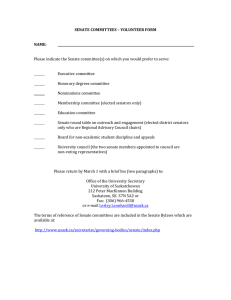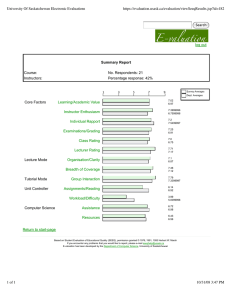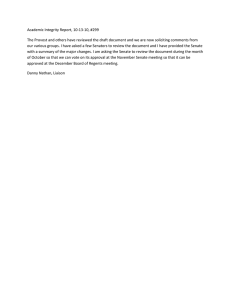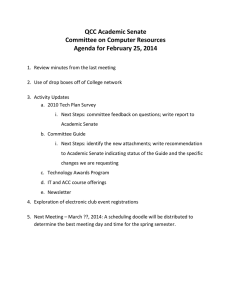Present: Vera Pezer (chair), D. Agema, J. Alexander, H. Allyn, L.... M. Beazely, H. Ben, R. Bhargava, G. Blackmore, E. Bourasssa,...
advertisement
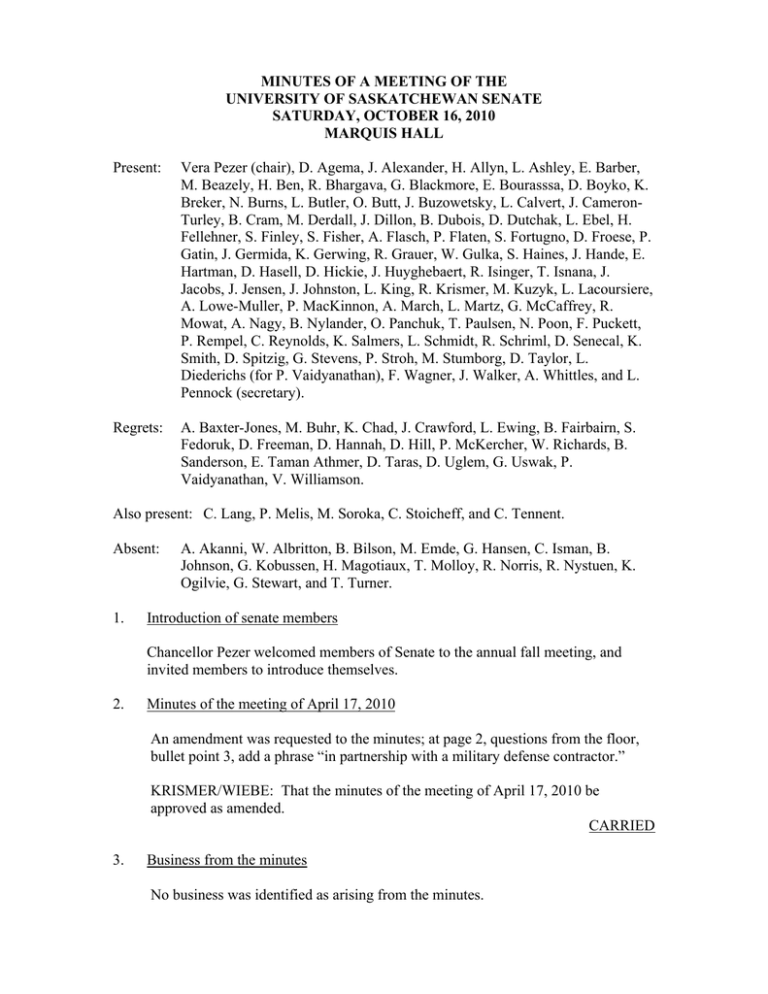
MINUTES OF A MEETING OF THE UNIVERSITY OF SASKATCHEWAN SENATE SATURDAY, OCTOBER 16, 2010 MARQUIS HALL Present: Vera Pezer (chair), D. Agema, J. Alexander, H. Allyn, L. Ashley, E. Barber, M. Beazely, H. Ben, R. Bhargava, G. Blackmore, E. Bourasssa, D. Boyko, K. Breker, N. Burns, L. Butler, O. Butt, J. Buzowetsky, L. Calvert, J. CameronTurley, B. Cram, M. Derdall, J. Dillon, B. Dubois, D. Dutchak, L. Ebel, H. Fellehner, S. Finley, S. Fisher, A. Flasch, P. Flaten, S. Fortugno, D. Froese, P. Gatin, J. Germida, K. Gerwing, R. Grauer, W. Gulka, S. Haines, J. Hande, E. Hartman, D. Hasell, D. Hickie, J. Huyghebaert, R. Isinger, T. Isnana, J. Jacobs, J. Jensen, J. Johnston, L. King, R. Krismer, M. Kuzyk, L. Lacoursiere, A. Lowe-Muller, P. MacKinnon, A. March, L. Martz, G. McCaffrey, R. Mowat, A. Nagy, B. Nylander, O. Panchuk, T. Paulsen, N. Poon, F. Puckett, P. Rempel, C. Reynolds, K. Salmers, L. Schmidt, R. Schriml, D. Senecal, K. Smith, D. Spitzig, G. Stevens, P. Stroh, M. Stumborg, D. Taylor, L. Diederichs (for P. Vaidyanathan), F. Wagner, J. Walker, A. Whittles, and L. Pennock (secretary). Regrets: A. Baxter-Jones, M. Buhr, K. Chad, J. Crawford, L. Ewing, B. Fairbairn, S. Fedoruk, D. Freeman, D. Hannah, D. Hill, P. McKercher, W. Richards, B. Sanderson, E. Taman Athmer, D. Taras, D. Uglem, G. Uswak, P. Vaidyanathan, V. Williamson. Also present: C. Lang, P. Melis, M. Soroka, C. Stoicheff, and C. Tennent. Absent: 1. A. Akanni, W. Albritton, B. Bilson, M. Emde, G. Hansen, C. Isman, B. Johnson, G. Kobussen, H. Magotiaux, T. Molloy, R. Norris, R. Nystuen, K. Ogilvie, G. Stewart, and T. Turner. Introduction of senate members Chancellor Pezer welcomed members of Senate to the annual fall meeting, and invited members to introduce themselves. 2. Minutes of the meeting of April 17, 2010 An amendment was requested to the minutes; at page 2, questions from the floor, bullet point 3, add a phrase “in partnership with a military defense contractor.” KRISMER/WIEBE: That the minutes of the meeting of April 17, 2010 be approved as amended. CARRIED 3. Business from the minutes No business was identified as arising from the minutes. Senate Meeting 4. -2- October 16, 2010 President’s report The president drew the attention of Senate members to the achievement record circulated at the door; the document reflects the university’s tracking and reporting of key activities that measure the success of initiatives undertaken in support of its institutional planning. He then commented on the results of the recent census day, which show an increase in undergraduate enrolment of 1.85% and a substantial rise in the number of graduate students registered in master’s and doctoral programs, to 15%. He also reported an increase in the number of aboriginal students, up 5.77%, and commented on the rapid growth of enrolment in the university’s three new graduate schools. He expressed gratitude for the work of the admissions office and particularly Claude Lang, its director, in contributing to the success of the enrolment plan. President MacKinnon then provided comments on the new nursing program that has recently been announced by the province, and he described the structure of the programs and their relation to other programs at the University of Regina and SIAST. The new program has a focus on interprofessional education and distributed education across the province. The president reported on his recent provincial tour to North Battleford, and on the Board of Governors’ community dinner and retreat earlier this week in Swift Current and Cypress Hills. Finally he reported that the undergraduate student residence in the College Quarter is in an advanced stage of construction, and the university will shortly turn sod on a graduate student residence. Along with the soon-to-be begun second phase of the undergraduate residence, the university will have doubled its capacity for student housing over the last three years. There were questions and comments from Senate members on the following topics: • The availability of day care facilities in the new residences • The status of Kenderdine Campus in the university’s planning and capital priorities • Funding for graduate studies in fine arts, where a senate member had heard reports of budget cuts. The dean committed to looking into this. • The potential for Saskatoon’s business community if the university were to be able to leverage its synchrotron science with a neutron research reactor. • Whether a breakdown by department and program is available for the increase in graduate student numbers. • Whether more information will be available to Senate about the recent land purchase and transfer of agricultural activities to this new land, and the prospective infrastructure costs. • Whether emergency plans are in place for InterVac if a virus were to escape from the Level 3 facility, and what oversight is in place. • An expression of thanks for the provision of a question period provided at the end of the meeting, and the hope this tradition will continue. Senate Meeting • • • -3- October 16, 2010 A comment on the excellence of the nursing process, and a question about the admission process and requirement. A Senate member who teaches at SIAST indicated there had been a great deal of misperception about admission to the program. The need for additional funding for the Gordon Oakes Redbear Centre, and an expression of interest from Senate members in helping to achieve the vision of this centre. Appreciation for a recent two-page spread in the Regina Leader-Post and for the University of Saskatchewan’s increasing presence in the south of the province. 5. Report on undergraduate student activities Chris Stoicheff, President of the USSU, began his report by recognizing members of the University Student Council in attendance as members of Senate. He indicated that it is an honour and privilege for him to address Senate as the president of the USSU, which has a proud tradition of speaking up on issues of accessibility and quality of education and of engaging with the local community. He reported that the student union has been taking a leadership role in some important areas: child care on campus, engaging in aboriginal awareness, scholarship and funding issues, student housing, the Place Riel renovation and expansion, and community engagement. On the child care issue, he reported that a task force has been established by the university at the request of the students to establish an action plan, and he thanked the president and his executive for responding quickly to this call. The USSE held a rally for child care on campus on September 22 in the bowl and raised over $400 in just a few hours. On the aboriginal student presence, Mr. Stoicheff noted that this university has more aboriginal students than any other post-secondary institution in Canada including FNUC. For the first time the students have elected an aboriginal student as a member of the executive (Leon Thomson). The students are trying to combat a lack of awareness of aboriginal influence and the prevalence of myths—such as that all aboriginal students get their education paid for. The USSU recently signed a treaty awareness memorandum of understanding with the treaty commissioner and launched a “We are all treaty people” campaign. They are also lobbying for an elimination of the cap on funding for aboriginal students, and fully support the university in its search for funding for a new aboriginal student centre. The USSU is also lobbying the provincial government for better scholarship support, since this is one of the few provinces not to have a provincial scholarship fund. Another area where the university is behind its peers is with respect to the availability of student housing: the university understands this and has committed funding as of last week to begin work on Phase 2 of a major student housing project. This is a huge investment in the student experience. Mr. Stoicheff indicated that this will be an exciting year for students on campus with the completion of the Place Riel renovation and expansion project, which will provide Senate Meeting -4- October 16, 2010 new food, retail and club and service spaces. In addition the top two floors will be home to the new student health and counseling centre. Finally, the USSU is giving back to community through various community and charitable activities, including Trick or Eat, a Habitat for Humanity build, Green Yourself Week, Academic Integrity Awareness Week, the Campus for All program in collaboration with Saskatchewan Community Living, the creation of a Saskatchewan Student Coalition, a Red Cross benefit, and Take Back the Night Event. He indicated that students are working to create a more inclusive and high quality campus for everyone. 6. Report on graduate student activities Omeasoo Butt, president of the Graduate Students’ Association, began by pointing out the excellent relationship that exists between the GSA and the USSU, and indicated that her association is involved with and supportive of many of the USSU’s initiatives including the day care task force initiative. She also pointed out that not only does the GSA now have two aboriginal students on their executive, but they have also revitalized their aboriginal graduate student council. Ms. Butt invited Senate members to stop in to see the new graduate student commons in the former College of Emmanuel and St. Chad chapel. She particularly thanked Colin Tennent and Lawrence Martz for their work in helping with fundraising, noting that each have donated personally to make up the shortfall. The commons supports the association’s goals of developing sense of community among graduate students and being more interdisciplinary. The first-ever graduate student art show will be held in the commons on November 29, and she would be happy to hear from other graduate students who would like to show their work. An important interdisciplinary conference on academia in society is being sponsored by the graduate students in November, and Senate members would be welcome to attend and/or to send representatives from their community organizations. The GSA is trying to build education and awareness on campus that next year tuition fees for international graduate students will go up to 1.5 times the regular tuition. Finally, Ms. Butt encouraged senate members to consider whether they know of graduate students who might be interested in running for the vacant post of vicepresident academic. There was a question from a Senate member concerning the reasons for graduate students’ having voted down participation in the U-PASS bus program, and whether there was any provision for graduate students opting in. Senate Meeting 7. -5- October 16, 2010 Items for approval from Senate committees 7.1 Senate executive committee re position profile for Chancellor STROH/BOURASSA: That Senate approve the position profile for the chancellor included in the agenda material. CARRIED 8. Items for information from Senate committees 8.1 Nominations committee report This report was presented by Bev Dubois and was received for information. 8.2 Senate roundtable on outreach and engagement report This report was received for information. 8.3 Report on non-academic student discipline This report was presented by the university secretary and was received for information. 9. Items from University Council 9.1 Changes to Mathematics admission requirements for direct entry colleges REMPEL/BUZOWETSKY: That Senate approve revisions to the high school mathematics admission requirements to reflect the new high school mathematics curriculum as described in the agenda materials. CARRIED 10. Presentations and discussion 10.1 Presentation on Assessment Initiatives Pauline Melis made a presentation on institutional assessment; the slides are attached as Appendix A. She also distributed a document entitled “Survey Synthesis” that provides an overview of results on university-wide surveys at the University Saskatchewan undertaken over the past 10 years. Ms. Melis then took Senate members through the newly-produced Achievement Record and explained the purpose of the document. She encouraged Senate members to view the achievement record on line at www.usask.ca/achievementrecord. There was a question about how the perception by students that they are not well prepared translates into their actual success in programs. There was also some discussion about the extent to which indicators can measure the things we want them to measure, and a comment that some indicators (such as GDP and wait times Senate Meeting -6- October 16, 2010 for medical procedures) are not really getting at the heart of the issue. A Senate member wondered how the university might be able to measure such things as student acquisition of critical skills and understanding of their roles as citizens, and whether the measures being adopted are too utilitarian, or not community-focused enough. A question about the recent report on advising at the university prompted responses from the former Vice-provost for Teaching and Learning and from the Dean of Arts and Science about what the university has learned from the report and what actions will be taken to address the needs that were uncovered. The dean indicated that her college will be integrating academic advising into the duties of every professor, and ensuring that every student has access to advising before they arrive and during first year, to improve the student experience and to improve retention rates. 10.2 Discussion of the development of the Third Integrated Plan Pauline Melis also presented this item, beginning with a review of Senate’s prior and continuing involvement in the university’s planning processes. She identified today’s session as the first of two opportunities the Senate will have to influence the development of the university’s third integrated plan, scheduled to be completed in the spring of 2012. She drew members’ attention to the report on the progress of implementation of the second integrated plan that was included in the agenda materials. Ms. Melis commented on the president’s role in setting direction and in reinforcing and reminding the community of the importance of the strategic directions, and also indicated that the main messages the integrated planning office has received from the university’s community are that these directions should continue to guide the university into the third planning cycle and that the plan must remain focused on a few key strategic goals. Ms. Melis then invited a discussion of the most important thing the university should do by 2016. She indicated that the responses should cross all colleges and units and should be relevant to each of the university’s three missions of research, teaching and outreach. They should assume the university’s imperatives—in the areas of internationalization, aboriginal engagement, and innovation—remain valid and central to the university’s directions. There was a suggestion from a member that the university must ensure that its aspirations to be a research-intensive institution take into account the needs of its community. Ms. Melis then invited any members who wished to do so to share their insights and ideas. Members made the following observations: • It will be important to improve the student completion rate from the current rate of 55%. • The university should aspire to be a caring and respectful place (e.g. valuing its employees and faculty, helping students complete their programs, providing quality day care). Senate Meeting -7- October 16, 2010 • The university should enhance its connection to off-campus and rural communities in order to be seen as a service to the people of the province. • The university could provide a set of classes that are suited to certain interests and needs that students can register in as a package, making it easier for new and particularly rural students to register, and streamlining academic advising. • Education should be accessible for all students, so all students know this university is here for them. This would include engaging at-risk youth and supporting them through their studies, and making housing more accessible. • We need to try to understand what the world is going to be in 2017; we have to be one of the best at anticipating the future. • Look at where the university is taking the province. In 2017 will we have an industrial bioeconomy? What role will sustainability and natural resources play? The answer might lie in the intersection of agriculture, the north, aboriginal peoples, natural resources, and technology and sustainability. • The university could become a tuition-free university in the home of medicare. The community owns the university and builds it, intellectuals and innovators are born into any household anywhere, not just those who are able to afford it. • Capital projects are everywhere now; it will be important for a level of transparency when it comes to prioritizing the capital projects we go ahead with. 11. Other business No other business was raised by Senate members. 12. Question Period There was a question about a recent news report on how the public school system in Saskatoon is handling cases of plagiarism, and one about whether the university had looked at the completion rates and success rates of part-time students. There was also a suggestion that the university could be using its Regional Advisory Councils more effectively to reach into the community. 13. Adjournment and next meeting of Senate The meeting adjourned at 2:05 p.m. Next meeting is Saturday, April 16, 2011. What is Planning? “Integrated Planning is a process that brings together university‐level and college/unit‐ specific initiatives, which permits strategic decision‐making and provides a synoptic view of resources and commitments. The purpose of integrated planning is to align academic priorities with financial and capital resources in order to ensure the responsible use of all resources.” Assessment at the University of Saskatchewan Presented by Pauline Melis, Assistant Provost, Institutional Planning and Assessment University Senate Meeting, October 16, 2010 www.usask.ca The Second Integrated Plan: Quality & Accountability Commitment The University of Saskatchewan will put forward a comprehensive quality improvement and assurance framework and communicate progress at regular intervals. www.usask.ca A Framework for Assessment Approved by Council and Board in 2008 Defines assessment at the U of S Provides guiding principles and purposes Outlines areas of priority to assess Contains initial implementation plan for university‐wide assessment activities www.usask.ca What is Assessment? www.usask.ca Why do we Assess? “…the systematic collection, review, and use of information about educational programs, research performance, and organizational structures undertaken for the purposes of improving student learning and development, improving and assuring quality in program and service offerings, stimulating creative research and scholarly endeavours, and achieving alignment with institution‐wide goals.” www.usask.ca To be accountable to a variety of stakeholders To confirm quality and excellence in programs and services To meet national/international standards To know how we are doing and where to improve To ensure our programs and services are competitive with peers To provide evidence of impact of our activities and to inform decision‐making To inspire shared confidence www.usask.ca 1 Role of the IPA A collaborative team which serves multiple roles: The IPA Assessment Work Plan Leadership Co‐ordination across the university Partnering with other units Modelling exemplary practices and processes Providing guidance and advice to the campus community IPA’s main focus is to support institutional planning and assessment; it is able to assist colleges and units with selective planning and assessment activities Assessing teaching, learning and the student experience (Surveys, Survey Plan, Survey Tool and Survey Guidelines) Measuring progress toward institutional goals (Achievement Record, Progress Report on IP2) Reviews of graduate programs as well as reviews of selected units, services or functions Reputational rankings (Macleans, Globe and Mail, international) Teaching quality and effectiveness (SEEQ) Increased communications about assessment to promote understanding and support transparency goals www.usask.ca Survey Synthesis www.usask.ca Overall Satisfaction This synthesis represents a decade of student opinion about the teaching and learning environment experienced by students. When finalized and ‘published’, this package includes a series of online fact sheets focusing on various themes/aspects of the student experience as reported by survey participants over the past decade. The synthesis was developed to ensure that the student voice is included in the planning of colleges and administrative units and in the university’s plan. This information will be provided to attendees at the Community Planning Event on October 29 to further inform the development of the University’s Third Integrated Plan. Overall quality of education The U of S ranked first place among 8 universities in the medical/doctoral category in 2008. U of S graduating students are more satisfied than their peers at other medical/doctoral universities Attending the U of S Overall, U of S students are very satisfied with their decision to attend the U of S and their level of satisfaction has grown steadily since 2002 and they would likely recommend the U of S to others. Students’ expectations The U of S has also significantly improved in meeting or exceeding students’ expectations Sense of belonging Generally, U of S students have a greater sense of belonging than students in other medical/doctoral universities www.usask.ca www.usask.ca Aboriginal Students Pre‐University Demographics Aboriginal students are more likely to be from Saskatchewan, to be older, to have children, and to have attended PSE prior to U of S Reasons to attend the U of S Proving that they can be successful and helping their families and communities financially are important reasons to attend university for Aboriginal students Overall satisfaction Aboriginal students are more satisfied with their overall experiences but are less satisfied with their non‐academic learning experiences Academic experience Aboriginal students encounter greater personal, social and academic difficulty even though they are generally engaged www.usask.ca Where do our students come from? An increasing number of students enter university immediately after graduating from high school How do our students apply to the U of S? 20% of students have also applied for other universities. Those that do are applying to more universities than 2 and are more likely to apply to more out‐of‐province universities. The U of S, is still the 1st choice for more than 90% of students Why do our students come to the U of S? The main reason undergraduate students choose the U of S is location; Graduate students select the U of S because of reputation of faculty or program of study Do our students come prepared? Although SK students generally have higher grades in high school, they feel less prepared than out‐of‐province and international students www.usask.ca 2 Student Financing Achievement Record Sources of financing The most common sources of financing are parents and family, government loans and summer or part‐time employment Student debt In 2009, 64% of undergraduate students in direct‐entry programs had accumulated debt and the average amount of debt was $29,930 Student financial aid The percentage of first‐year U of S students receiving financial aid from the U of S increased more than 3 times from 2004 to 2010 Student employment Approximately half of students were employed while studying. The majority of students felt it negatively affected their academic performance Created to gauge progress of the university’s strategic directions, and to adequately represent this progress to our community and the public at large First published in October 2009, primarily paper format (online pdf). In early October 2010, the second iteration was released in both online and print formats. New to the Achievement Record this year: Inclusion of targets and benchmarks for most indicators Dynamic functionality in the online format allowing inquirers to find more detailed information on each indicator. www.usask.ca www.usask.ca Other Assessment Initiatives: Reviews: http://www.usask.ca/ip/assessment/reviews/index.php Graduate Program Review (with College of Graduate Studies and Research) Selective Reviews of Units, Functions, Services Reviews of Research Centres www.usask.ca/achievementrecord/ Rankings Canadian: Macleans and Globe and Mail International: To be determined Next steps www.usask.ca www.usask.ca Questions and Discussion The Third Integrated Plan Presented by Pauline Melis, Assistant Provost, Institutional Planning and Assessment University Senate Meeting, October 16 2010 www.usask.ca www.usask.ca 3 Planning Cycles The Second Integrated Plan www.usask.ca Development of the Third Plan 2010 Jan 2011 Jun Aug Campus Community Survey 2012 Phase 1 Phase 3 Phase 5 Strategic Directions refreshed College and unit planning begins Consultation on institutional plan Phase 4 Approvals by Board of Governors and University Council Phase 6 College and Unit Plans Submitted by Oct. 15 Phase 2 Early stages of college and unit planning Campus Planning Event www.usask.ca Implementation begins Review of college and unit plans to support the planning parameters development process Focal Areas Released One question survey – “What is the most important thing for the University of Saskatchewan to do before 2016?” Open online since September 20 400 responses and counting A way to engage the broad campus community in planning process for the third plan without being overly intrusive Dec www.usask.ca www.usask.ca Today’s Discussion Topic What is the most important thing for the university to do by 2016? www.usask.ca 4
